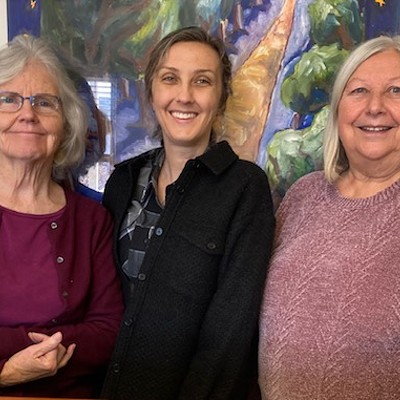EXHIBIT: McCarthy Arts Center Gallery, St. Michael's College, Colchester. Through November 3.
ARTWORKThe Luminous People and Land," paintings of South Africa by Sally Linder
Sally Linder is a local artist with global concerns. In the late 1990s she painted portraits of apes and buried them in Asia and Africa to raise awareness about the plight of primates in captivity. More recently she helped create the "Ark of Hope," the repository of a papyrus copy of the "Earth Charter," an internationally drafted document regarding sustainable development. That project has been shown around the world as a clarion call against environmental degradation.
In 2002 Linder took the Ark of Hope to Johannesburg, where an environmental summit was taking place. She spent much of her time in the black South African townships of Soweto, Zandspruit and Diepsloot. This experience inspired a group of figurative acrylic paintings that are currently on view at the McCarthy Arts Center Gallery at St. Michael's College. Her aptly titled exhibition, "The Luminous People and Land," comprises five large triptychs, 23 small portraits of children and several medium-sized paintings Linder terms "vignettes."
Though poverty and hardship are evident in these works, Linder generally depicts life in the townships with a sanguine view. Her paintings are teeming with pattern, hot color and texture. Her child portraits are grouped together on a wall as an aggregation of paintings stacked eight abreast and four tall. The children gaze straight out at the viewer, as in snapshots.
Linder's vignettes seem to tell individual stories and scenes of life in the townships. There are no home interiors, but her portrayals of residents doing chores or enjoying each other's company outdoors capture scenes of intimate familiarity. Unlike the child portraits, many of Linder's adult subjects seem not to notice the artist -- perhaps this white, blonde, blue-eyed American woman managed somehow to blend in?
"Women Playing Cards" is a 22-by-24-inch painting crowded with crimson, zebra-like stripes, as patterns in the clothing of the card players and the onlookers. But the invented patterning travels into the background as well, as Linder allows figures and their surroundings to blend into each other. She is fluent in her use of acrylics, versatile and adept with color and design.
The 30-by-22-inch vignette "Three Women Talking" is a vertical composition splashed with purple, indigo and ruddy orange. The scene is simple, just three African women in flowing clothes chatting together. But Linder's chromatic harmonies are complex, possessing incremental shifts of hue. An acidic light green acts as the foundation for her fiery complementary colors.
Contemporary triptychs descend from traditional European altarpieces, which were like illustrated religious books that stood in front of illiterate congregations. Linder's triptychs open and close in the same manner, inviting a comparison with holiness, and have the scale of traditional altarpieces as well. Her largest is "Luminous Beings," which is 44 by 100 inches when opened and 44 by 30 inches when closed. The closed triptych portrays two boys, ensconced in a flurry of warm colors. Small circles, perhaps symbols of interconnectedness, float through the atmospheric background. A large circle rings the entire rectangular composition. The triptych opens to reveal a cluttered landscape of thin figures and corrugated tin shanties. As in other works here, Linder has extended her scenes around all the edges, covering every inch of the canvasses.
The open 34-by-96-inch triptych "Black Madonna" also describes life in a shantytown, with tin huts stretching from foreground to horizon. Just right of center, a child looks directly at the viewer with -- uncharacteristically for Linder -- a somewhat sad face. Generating pathos, however, isn't her primary concern. True to Linder's artistic mission of encouraging hope and understanding, the closed triptych reveals an aged, smiling woman -- an Earth-goddess sort of image -- with lionesses behind her.
Linder is an exceptional painter, but for her, simply making pretty pictures in this not-always-pretty world isn't enough. She is also an activist with an ambitious agenda: world harmony.









Comments
Comments are closed.
From 2014-2020, Seven Days allowed readers to comment on all stories posted on our website. While we've appreciated the suggestions and insights, right now Seven Days is prioritizing our core mission — producing high-quality, responsible local journalism — over moderating online debates between readers.
To criticize, correct or praise our reporting, please send us a letter to the editor or send us a tip. We’ll check it out and report the results.
Online comments may return when we have better tech tools for managing them. Thanks for reading.